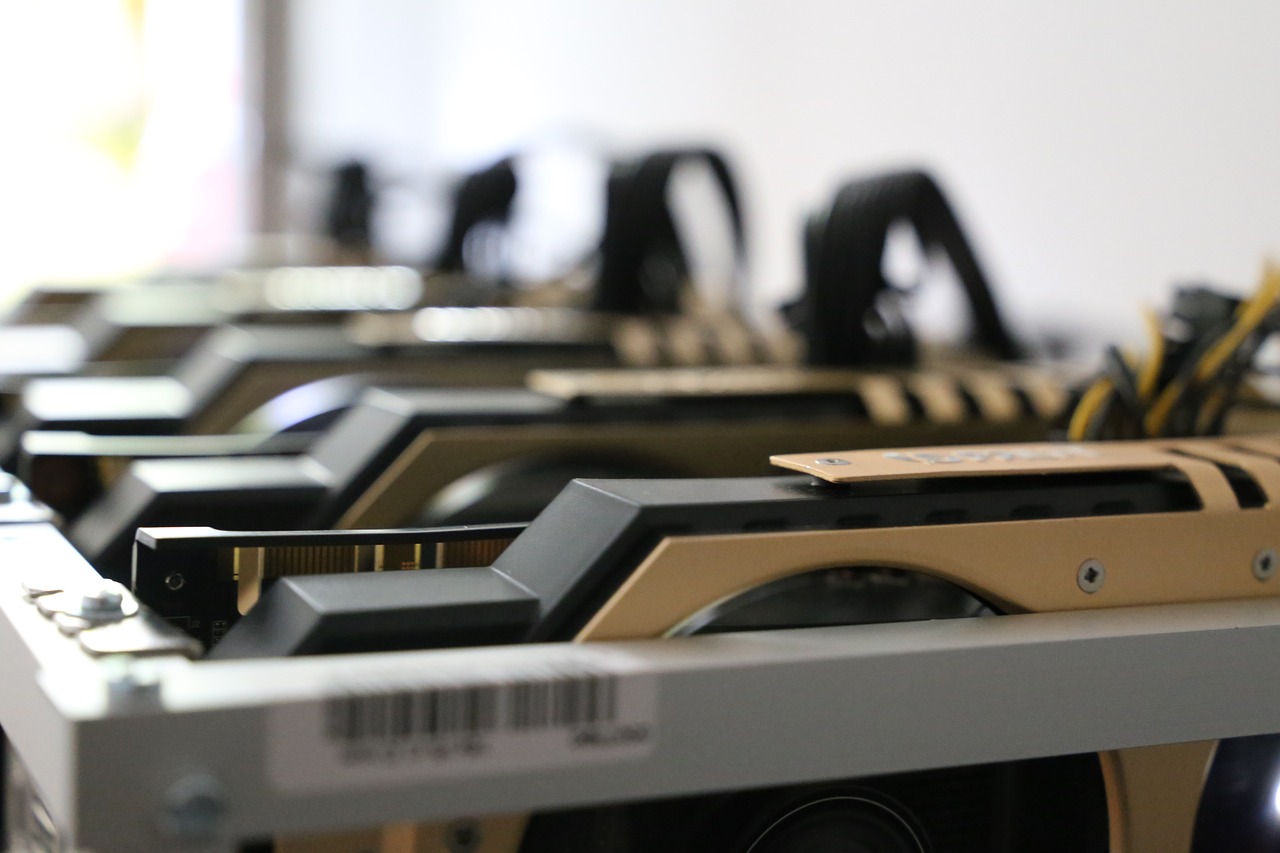How to Avoid Common Pitfalls in Crypto Investing
Investing in cryptocurrency can feel like stepping into a thrilling roller coaster ride. The excitement is palpable, but so are the risks. With the potential for high rewards comes the reality of significant losses. Therefore, understanding how to navigate this complex landscape is crucial for both novices and seasoned investors. In this article, we will explore essential strategies to help you steer clear of common mistakes that can lead to financial pitfalls in the world of crypto investing. It’s not just about picking the right coins; it’s about building a robust strategy that keeps your investments safe and sound.
Before you dive headfirst into the crypto ocean, it’s vital to have a solid grasp of the fundamental concepts surrounding it. Think of cryptocurrency as a digital asset that uses cryptography for security, making it difficult to counterfeit. At its core lies blockchain technology, a decentralized ledger that records all transactions across a network of computers. This transparency is one of the key reasons why many people are drawn to cryptocurrencies. However, it's essential to familiarize yourself with the different types of currencies available—like Bitcoin, Ethereum, and altcoins—and how transactions work. Without this foundational knowledge, you might find yourself lost in the vast sea of options and jargon.
One of the golden rules of investing is to never put your money into something you don’t understand. This is especially true in the volatile world of cryptocurrencies. Before investing, you should prioritize comprehensive research on various projects, their teams, and market trends. This means going beyond the flashy marketing and diving into the nitty-gritty details. By doing your due diligence, you can identify potential red flags and opportunities that others might overlook. Remember, in crypto investing, knowledge is not just power; it's your best defense against losses.
When researching a cryptocurrency project, one of the first things you should look at is its whitepaper. This document outlines the project's objectives, technology, and roadmap. Think of it as the blueprint for the project. Key elements to scrutinize include:
- Clarity of Goals: Are the goals clearly defined or vague?
- Technology Overview: Does the technology make sense, and is it feasible?
- Roadmap: Is there a clear timeline for development and milestones?
By carefully analyzing these aspects, you can gain valuable insights into the project’s potential for success or failure.
While evaluating whitepapers, it’s crucial to recognize warning signs that could indicate a scam or poorly conceived project. If you come across vague goals, unrealistic promises, or a lack of transparency, these should raise red flags. Trust your instincts; if something feels off, it probably is. The crypto space can be a breeding ground for fraud, so staying vigilant is essential.
Tokenomics refers to the economic model of a cryptocurrency, including its supply, demand, and distribution. Evaluating these factors is essential for assessing a coin's long-term viability and potential returns. For instance, a project with a limited supply may have more potential for value appreciation than one with an unlimited supply. Understanding how tokens are distributed and utilized within the ecosystem can also provide insights into the project's sustainability and growth prospects.
The cryptocurrency market is notoriously volatile and influenced by various factors, including news, regulatory changes, and technological advancements. Continuous monitoring of these trends is vital for adapting your investment strategies. Are there new regulations that could impact the market? Is a major player making moves that could shift the landscape? By staying informed, you can mitigate risks associated with sudden market shifts and make timely decisions that could protect your investments.
Implementing effective risk management techniques is key to surviving the ups and downs of the crypto market. Techniques like diversification and setting investment limits can help protect your assets and minimize losses. Think of it as not putting all your eggs in one basket; spreading your investments across different cryptocurrencies can reduce your risk exposure significantly.
Establishing achievable investment goals can guide your decision-making process and prevent emotional trading. In the fast-paced world of crypto, it’s easy to get swept away by excitement or fear. By setting clear, realistic goals, you can maintain focus and avoid impulsive actions that often lead to poor outcomes.
Another effective strategy is to utilize stop-loss orders. These orders automatically sell your assets at a predetermined price, helping you limit losses during market downturns. This approach not only protects your investments but also encourages a disciplined investment strategy, allowing you to stick to your plan even when emotions run high.
Finally, understanding the psychological factors that can influence your trading decisions is crucial. The thrill of a sudden price surge can lead to impulsive actions, while fear of missing out (FOMO) can prompt hasty decisions. By recognizing these emotional traps, you can maintain a rational perspective and avoid actions that could lead to financial setbacks. Remember, investing should be a calculated decision, not a game of chance.
Q: What is the best way to start investing in cryptocurrency?
A: Begin by educating yourself on the basics, researching different cryptocurrencies, and starting with a small investment that you can afford to lose.
Q: How can I protect my investments in cryptocurrency?
A: Utilize risk management strategies like diversification, setting stop-loss orders, and staying updated on market trends to safeguard your investments.
Q: What are red flags to watch for in cryptocurrency projects?
A: Look for vague goals, unrealistic promises, lack of transparency, and poorly defined tokenomics as potential warning signs.

Understanding Cryptocurrency Basics
Before you jump headfirst into the exhilarating world of cryptocurrency investing, it’s absolutely essential to have a solid grasp of the fundamental concepts that govern this innovative financial landscape. Think of cryptocurrency as a new language; if you don’t understand the basics, you’ll struggle to communicate effectively and make informed decisions. So, let’s break it down into bite-sized pieces, shall we?
At its core, cryptocurrency is a digital or virtual currency that uses cryptography for security. Unlike traditional currencies issued by governments, cryptocurrencies operate on a technology called blockchain. Imagine a blockchain as a digital ledger that records all transactions across a network of computers. This decentralized nature not only enhances security but also eliminates the need for intermediaries like banks. Isn’t that fascinating?
There are thousands of different cryptocurrencies available today. Some of the most well-known include:
- Bitcoin (BTC): The first and most widely recognized cryptocurrency.
- Ethereum (ETH): Known for its smart contract functionality.
- Ripple (XRP): Focused on facilitating cross-border payments.
Each of these currencies has its own unique features and purposes. For instance, while Bitcoin is often viewed as digital gold, Ethereum serves as a platform for decentralized applications. Understanding the different types of cryptocurrencies is crucial for making informed investment choices.
Now, let’s talk about how transactions work. When you send or receive cryptocurrency, the transaction is recorded on the blockchain. This process involves a few key steps:
- The sender initiates a transaction using their digital wallet.
- The transaction is broadcasted to the network for validation.
- Miners (or validators) confirm the transaction and add it to the blockchain.
- The recipient's wallet reflects the new balance.
This entire process is typically completed within minutes, showcasing the efficiency of cryptocurrency transactions compared to traditional banking methods. However, it’s essential to remember that the crypto market is highly volatile, which means prices can fluctuate dramatically in short periods. Understanding these basics will help you navigate the complexities of crypto investing with greater confidence.
In summary, diving into cryptocurrency investing without understanding its basics is like sailing a ship without a compass. You might find yourself lost in the vast ocean of digital currencies. So, take your time to learn about blockchain technology, the various types of cryptocurrencies, and how transactions work. This foundational knowledge will empower you to make smarter investment decisions and avoid common pitfalls down the road.

Conducting Thorough Research
When it comes to cryptocurrency investing, the age-old adage "knowledge is power" couldn’t ring more true. Before you even think about putting your hard-earned cash into the digital currency space, you need to roll up your sleeves and dig deep into research. This isn’t just a casual stroll through Google; it’s a full-on investigative mission! The crypto market is filled with opportunities, but it’s also teeming with potential pitfalls. By conducting thorough research, you can arm yourself with the necessary insights to make informed decisions and steer clear of costly mistakes.
First off, let’s talk about the projects you’re interested in. Each cryptocurrency is backed by a project that has its own unique vision and goals. So, what’s the first step? Start by examining the team behind the project. Who are they? What’s their track record? Are they transparent about their qualifications and experience? A solid team can be a strong indicator of a project’s potential success. If the project’s team is shrouded in mystery, that’s a red flag you shouldn’t ignore.
Now, onto the nitty-gritty: the project’s whitepaper. This document is like a blueprint for the project and should provide a comprehensive overview of its objectives, technology, and roadmap. When diving into a whitepaper, look for key elements such as:
- Clear Objectives: Does the project have a well-defined purpose?
- Technical Feasibility: Is the technology behind the project sound?
- Roadmap: Are there clear milestones and timelines for development?
But don’t just stop there. You also need to evaluate the tokenomics of the cryptocurrency. This refers to the economic model of the token, including factors like supply, demand, and distribution. Understanding tokenomics is crucial because it can give you a glimpse into the long-term viability of the cryptocurrency. For instance, a project with a capped supply may create scarcity, potentially increasing its value over time. Conversely, if a project has an unlimited supply, it might lead to inflation, diluting your investment.
As you conduct your research, keep an eye out for red flags. These can include vague goals, unrealistic promises, or a lack of transparency regarding the project’s operations. If something feels off, trust your gut. The crypto world is rife with scams, and being able to identify these warning signs can save you from falling victim to a poorly conceived project.
Finally, staying updated on market trends is paramount. Cryptocurrency is a fast-moving landscape, and what’s relevant today may not be tomorrow. By continuously monitoring news, regulatory changes, and market conditions, you can adapt your investment strategies accordingly. This proactive approach can help you mitigate risks associated with sudden market shifts and keep your investment portfolio healthy.
In summary, conducting thorough research is not just a suggestion; it’s a necessity for anyone looking to invest in cryptocurrency. By understanding the projects, evaluating whitepapers, scrutinizing tokenomics, and staying informed about market trends, you’ll be better equipped to make decisions that align with your financial goals. Remember, in the world of crypto, knowledge truly is your best ally!
- What is a whitepaper? A whitepaper is a detailed document released by a cryptocurrency project that outlines its goals, technology, and roadmap.
- Why is tokenomics important? Tokenomics helps investors understand the economic model of a cryptocurrency, including supply and demand dynamics.
- How can I identify red flags in a crypto project? Look for vague goals, unrealistic promises, and lack of transparency in the project's operations.

Evaluating Project Whitepapers
When it comes to cryptocurrency investing, one of the most critical steps is evaluating a project's whitepaper. Think of a whitepaper as the blueprint of a building; it outlines the project's vision, technology, and roadmap. By diving deep into this document, you can gain invaluable insights that can guide your investment decisions. But what exactly should you be looking for? Let’s break it down.
First and foremost, you should assess the clarity and completeness of the whitepaper. A well-structured whitepaper will clearly articulate the problem the project aims to solve and how it plans to achieve that. If the document is filled with jargon and vague statements, it could be a red flag. Look for specific details about the technology being used, the team behind the project, and the timeline for development.
Another essential aspect to evaluate is the team background. A project is only as strong as the people behind it. The whitepaper should provide information about the team members, their qualifications, and their previous experience in the industry. If the team has a solid track record, it’s likely they have the expertise to bring their vision to life. Conversely, if the team is anonymous or lacks relevant experience, you might want to tread carefully.
Next, don’t overlook the roadmap. This section should outline the project's milestones and future plans. A realistic timeline indicates that the project is well thought out and has achievable goals. If the roadmap is overly ambitious or lacks specific dates, it could signal that the project is not grounded in reality. You want to invest in projects that have a clear path forward, not those that are just shooting for the stars without a plan.
Additionally, understanding the tokenomics of the project is crucial. This refers to the economic model of the cryptocurrency, including how tokens are distributed, the total supply, and the incentives for holders. A well-designed tokenomics model can significantly impact the project's success. Make sure to look for details on how the tokens will be used within the ecosystem and whether there are mechanisms in place to ensure demand and value appreciation over time.
Finally, always keep an eye out for red flags. If the whitepaper makes grandiose promises of high returns with little risk, it's time to be skeptical. Similarly, if you notice a lack of transparency or if the project seems to be avoiding answering tough questions, these could be signs of a potential scam. Trust your instincts and do not hesitate to dig deeper if something feels off.
In conclusion, evaluating a project's whitepaper is not just a box to check off on your investment checklist; it’s a vital part of your due diligence process. By focusing on clarity, team expertise, a realistic roadmap, sound tokenomics, and identifying red flags, you can make more informed decisions that could save you from costly mistakes in the unpredictable world of cryptocurrency.
- What is a whitepaper? A whitepaper is a document that outlines the purpose, technology, and roadmap of a cryptocurrency project.
- Why is the team background important? The expertise and experience of the team can greatly influence the success of the project.
- What should I look for in a roadmap? Look for clear milestones, realistic timelines, and achievable goals.
- What are tokenomics? Tokenomics refers to the economic model of a cryptocurrency, including supply, demand, and distribution mechanisms.
- How can I identify red flags in a whitepaper? Be cautious of vague promises, lack of transparency, and overly ambitious claims.

Identifying Red Flags
When it comes to investing in cryptocurrency, being able to spot red flags can mean the difference between a profitable venture and a financial disaster. Just like a seasoned detective looking for clues, you need to scrutinize every detail of a project before committing your hard-earned money. So, what should you be on the lookout for? Here are some critical warning signs that could indicate a project isn't what it claims to be:
- Vague Goals: If the project's objectives are unclear or overly broad, it raises a big red flag. A solid project should have well-defined goals that are easy to understand. If you can't figure out what they are aiming for, how can you trust them?
- Unrealistic Promises: Be cautious of projects that promise sky-high returns with little to no risk. If it sounds too good to be true, it probably is. Always remember the old adage: "If it walks like a duck and quacks like a duck, it's probably a duck."
- Anonymous Teams: Transparency is key in the crypto world. If the team behind the project is anonymous or has no verifiable track record, it’s a major red flag. You should know who is managing your investment.
- Lack of Community Engagement: A healthy project often has an active community. If the project's social media channels are quiet or the community is not engaged, it might indicate a lack of interest or investment in the project.
- Poorly Written Whitepaper: The whitepaper is your window into the project’s soul. If it’s riddled with jargon, spelling mistakes, or lacks depth, consider it a warning sign. A well-prepared whitepaper should clearly explain the technology, use cases, and roadmap.
Moreover, keep an eye on the tokenomics of the project. Understanding how the tokens are distributed, the total supply, and the mechanisms for creating value is crucial. If you notice that a large portion of tokens is allocated to the team or advisors, it could indicate that they might sell off their holdings, leading to a price drop and leaving investors in the dust.
To further illustrate, let's look at a simple table that summarizes some common red flags and their implications:
| Red Flag | Implication |
|---|---|
| Vague Goals | Lack of direction may lead to project failure. |
| Unrealistic Promises | Potential scam or unsustainable business model. |
| Anonymous Teams | High risk due to lack of accountability. |
| Poor Community Engagement | Indicates low interest or confidence in the project. |
| Poorly Written Whitepaper | May indicate a lack of professionalism or knowledge. |
In conclusion, identifying red flags is a vital skill for any crypto investor. By being vigilant and doing your homework, you can navigate the murky waters of cryptocurrency investing more safely. Remember, the goal is not just to find the next big thing but to protect your investments from potential scams and poorly conceived projects.
1. What are the most common red flags to look for in a cryptocurrency project?
The most common red flags include vague goals, unrealistic promises, anonymous teams, lack of community engagement, and poorly written whitepapers.
2. How can I verify the team behind a cryptocurrency project?
You can check their LinkedIn profiles, previous projects, and any public information available. Transparency is key, so look for teams that are open about their identities and backgrounds.
3. Is it safe to invest in new cryptocurrency projects?
Investing in new projects can be risky. Always conduct thorough research and look for red flags before investing. Diversification can also help mitigate risks.
4. What should I do if I spot a red flag?
If you identify a red flag, reconsider your investment. It’s better to miss out on a potential opportunity than to lose money on a risky project.

Understanding Tokenomics
When it comes to investing in cryptocurrency, tokenomics is a term that often gets thrown around, but what does it really mean? In simple terms, tokenomics refers to the economic model surrounding a cryptocurrency, including its supply, demand, and distribution. To make informed investment decisions, you need to dive deep into these elements, as they can significantly influence the value and longevity of a crypto asset.
First off, let's talk about supply. Every cryptocurrency has a total supply, which is the maximum amount of coins or tokens that will ever exist. For instance, Bitcoin has a capped supply of 21 million coins. Understanding whether a cryptocurrency has a fixed supply or if more coins can be minted over time is crucial. A limited supply can create scarcity, which may drive up demand and price. On the other hand, an unlimited supply can dilute the value of existing tokens.
Next, we have demand. This is where things get interesting. Demand for a token can fluctuate based on various factors such as market trends, utility, and community interest. For example, if a cryptocurrency is tied to a popular application or platform, the demand for its tokens may skyrocket as users flock to use the service. Conversely, if the project fails to deliver on its promises or loses community support, the demand can plummet, leading to significant losses for investors.
Now, distribution is another key aspect of tokenomics. It refers to how the tokens are allocated among various stakeholders, including developers, early investors, and the community. A fair and transparent distribution model can foster trust and encourage participation, while a skewed distribution can raise red flags. For example, if a large percentage of tokens are held by a small group of individuals, it can lead to market manipulation and a lack of liquidity.
To help visualize these concepts, let’s take a look at a simple table that summarizes the key components of tokenomics:
| Component | Description |
|---|---|
| Supply | The total number of coins or tokens that will ever exist. |
| Demand | The desire for the token based on its utility and market trends. |
| Distribution | How tokens are allocated among stakeholders, including developers and investors. |
In summary, understanding tokenomics is essential for any crypto investor. By evaluating the supply, demand, and distribution of a token, you can gain valuable insights into its potential performance and long-term viability. Always remember, a well-structured tokenomics model can be a strong indicator of a project's future success, while a poorly designed one can lead to disaster. So, before you invest your hard-earned money, take the time to analyze these elements carefully. It could mean the difference between hitting the jackpot and watching your investment go up in smoke.

Staying Updated on Market Trends
In the ever-evolving world of cryptocurrency, staying updated on market trends is not just a good practice—it's a necessity. Imagine trying to navigate a ship without a compass; that’s what investing in crypto can feel like if you’re not informed. The crypto market is notoriously volatile, with prices fluctuating wildly based on news, regulatory changes, and market sentiment. Therefore, keeping a finger on the pulse of the market is crucial for making informed decisions that can protect your investments and maximize your returns.
One of the best ways to stay informed is by following reputable news sources and cryptocurrency analysis platforms. Websites like CoinDesk, CoinTelegraph, and CryptoSlate provide up-to-date information on market trends, regulatory news, and technological advancements. Additionally, subscribing to newsletters or alerts can ensure that you receive timely updates directly to your inbox. This way, you won’t miss out on crucial developments that could impact your investment strategy.
Furthermore, engaging with the community can provide invaluable insights. Platforms like Twitter and Reddit host active discussions about market trends and emerging projects. By following industry leaders, analysts, and influencers, you can gain different perspectives that might help you identify potential opportunities or pitfalls. Remember, the crypto community is vast, and there’s a wealth of knowledge shared daily that could give you an edge in your investment decisions.
In addition to news and community engagement, utilizing market analysis tools can significantly enhance your understanding of market trends. Tools like TradingView and CoinMarketCap allow you to visualize price movements, trading volumes, and market capitalization. By analyzing charts and historical data, you can identify patterns that may indicate future price movements. Understanding technical analysis can be a game-changer, enabling you to make data-driven decisions rather than relying solely on gut feelings.
Lastly, don't underestimate the importance of following regulatory news. Governments around the world are continuously updating their stance on cryptocurrencies, and these regulations can have a profound impact on the market. For instance, news about a country banning or embracing cryptocurrencies can lead to immediate price swings. By keeping abreast of regulatory changes, you can better anticipate market movements and adjust your strategies accordingly.
In summary, staying updated on market trends is about more than just reading headlines. It involves a combination of following reliable news sources, engaging with the community, utilizing analytical tools, and keeping an eye on regulatory developments. By adopting a proactive approach to staying informed, you can navigate the complexities of crypto investing with greater confidence and success.
- How often should I check cryptocurrency news? It's advisable to check cryptocurrency news daily, as the market can change rapidly.
- What are the best sources for cryptocurrency news? Reputable sources include CoinDesk, CoinTelegraph, and CryptoSlate.
- How can I engage with the cryptocurrency community? You can join forums on Reddit, follow discussions on Twitter, and participate in local meetups.
- What tools can I use for market analysis? Tools like TradingView and CoinMarketCap are excellent for tracking price movements and market data.

Risk Management Strategies
When it comes to investing in cryptocurrencies, the landscape can be as unpredictable as a roller coaster ride. This is why having a solid risk management strategy is not just a good idea—it's essential. Think of it as your safety harness in the thrilling world of crypto. By implementing effective risk management techniques, you can protect your investments and minimize potential losses, allowing you to navigate the volatile market with confidence.
One of the most effective strategies is diversification. Imagine you're at a buffet: would you fill your plate with just one dish? Probably not! The same principle applies to investing. By spreading your investments across various cryptocurrencies, you're less likely to feel the sting if one of them takes a nosedive. Diversification can help cushion the blow and keep your portfolio healthy. For instance, you might consider allocating your funds as follows:
| Cryptocurrency | Allocation (%) |
|---|---|
| Bitcoin | 40% |
| Ethereum | 30% |
| Altcoins | 20% |
| Stablecoins | 10% |
Setting realistic goals is another cornerstone of effective risk management. It's easy to get swept up in the excitement of potential profits, but without clear, achievable objectives, you might find yourself making impulsive decisions. Ask yourself: what are you hoping to achieve with your investments? Whether it's saving for a vacation, buying a home, or simply growing your wealth, having a clear target can guide your decisions and keep your emotions in check.
Utilizing stop-loss orders is a technique that can also serve as a safety net for your investments. A stop-loss order is like having a guardian angel watching over your assets. By setting a predetermined price at which your asset will be sold, you can limit your losses during market downturns. This automatic mechanism helps maintain a disciplined approach to investing, allowing you to step back from the emotional turmoil that often accompanies market fluctuations.
In addition to these strategies, it's crucial to recognize the emotional traps that can derail even the most seasoned investors. The crypto market can evoke a whirlwind of emotions—from euphoria during bull runs to despair in bear markets. Understanding these psychological factors can help you maintain a rational perspective. It's essential to remember that trading decisions should be based on logic and research, not on fear or greed. Establishing a plan and sticking to it can help you avoid the pitfalls of impulsive trading.
In conclusion, managing risk in cryptocurrency investing is about creating a safety net that allows you to explore the market without losing your financial footing. By diversifying your portfolio, setting realistic goals, using stop-loss orders, and recognizing emotional traps, you can navigate the complexities of crypto investing with greater ease and confidence. Remember, the goal isn't just to survive the crypto roller coaster; it's to enjoy the ride while keeping your investments intact.
- What is the best way to diversify a crypto portfolio? Diversifying your portfolio involves investing in a mix of cryptocurrencies, including major coins, altcoins, and stablecoins, to spread risk.
- How can I set realistic investment goals? Start by assessing your financial situation and determining what you want to achieve with your investments, then create specific, measurable, achievable, relevant, and time-bound (SMART) goals.
- What are stop-loss orders, and how do they work? A stop-loss order is an instruction to sell a cryptocurrency when it reaches a certain price, helping to limit losses in a downturn.
- How can I avoid emotional trading? To avoid emotional trading, establish a clear trading plan, set rules for entering and exiting trades, and stick to your strategy regardless of market emotions.

Setting Realistic Goals
When it comes to crypto investing, is not just a smart move; it's a necessity. Think of your investment journey as a road trip. If you don't have a destination in mind, you're likely to wander aimlessly, wasting both time and resources. By establishing clear and achievable goals, you can effectively navigate the often turbulent waters of the cryptocurrency market.
First off, it's crucial to understand that the crypto landscape is notorious for its volatility. Prices can skyrocket one moment and plummet the next, which can be both exciting and terrifying. To avoid getting swept away by this rollercoaster, set specific goals that align with your financial situation and risk tolerance. For instance, ask yourself questions like:
- What am I aiming to achieve with my investments?
- Am I looking for short-term gains, or am I in it for the long haul?
- How much capital am I willing to invest, and what is my maximum loss limit?
By answering these questions, you can create a roadmap tailored to your personal circumstances. This is akin to plotting out rest stops on a long drive; it allows you to take breaks, assess your progress, and adjust your route if necessary. Moreover, it helps you maintain focus and avoid emotional decisions that could derail your investment strategy.
Another important aspect of goal-setting is the need for flexibility. Just as a road trip can encounter unexpected detours, the crypto market can change rapidly due to news, regulations, or technological advancements. Therefore, it’s wise to periodically review your goals and adjust them as needed. For instance, if a project you invested in suddenly gains traction, you might want to reassess your exit strategy or consider reinvesting profits into other opportunities.
Additionally, consider using the SMART criteria for your goals:
| SMART Criteria | Description |
|---|---|
| Specific | Your goals should be clear and well-defined. |
| Measurable | Establish criteria to measure your progress. |
| Achievable | Set goals that are realistic and attainable. |
| Relevant | Ensure your goals align with your overall financial objectives. |
| Time-bound | Set a timeline for achieving your goals. |
By following the SMART framework, you can create a structured approach to your investment goals that not only keeps you grounded but also motivates you to stay on track. Remember, the crypto market is filled with opportunities, but without a solid plan, it’s all too easy to get lost in the hype and make impulsive decisions that could lead to losses.
In conclusion, setting realistic goals in crypto investing is like having a compass on your journey. It guides you, helps you stay focused, and ensures that you’re making informed decisions rather than reacting emotionally to market fluctuations. As you embark on this exciting adventure, keep your goals in sight, adjust them as necessary, and watch your investment strategy flourish.

Utilizing Stop-Loss Orders
When it comes to navigating the rollercoaster ride of cryptocurrency investing, stop-loss orders can be your safety harness. You might be wondering, "What exactly is a stop-loss order?" Well, it's a tool that allows you to set a predetermined price at which your asset will automatically be sold. This means that if the market takes a nosedive, your investment can be protected from further losses. Think of it as a lifebuoy thrown into turbulent waters; it won't stop the waves, but it can keep you afloat.
Implementing stop-loss orders is not just about protecting your capital; it's also about maintaining a disciplined approach to your investment strategy. In the highly volatile crypto market, emotions can run high, and it's easy to get swept up in the moment, making impulsive decisions that can lead to regret. By setting a stop-loss order, you take some of the emotional weight off your shoulders. You’re not reacting to every dip and dive; instead, you’re allowing your strategy to guide your actions.
Now, let’s dive deeper into how to effectively utilize stop-loss orders. Here are some key points to consider:
- Determine Your Risk Tolerance: Before setting a stop-loss, assess how much you are willing to lose on an investment. This will help you decide where to place your stop-loss order.
- Choose the Right Type of Stop-Loss: There are different types of stop-loss orders, such as fixed stop-loss and trailing stop-loss. A fixed stop-loss sells your asset at a specific price, while a trailing stop-loss adjusts as the price moves in your favor, allowing for potential gains while still protecting against losses.
- Regularly Review Your Orders: The crypto market is dynamic, and what worked yesterday may not work today. Regularly review and adjust your stop-loss orders based on market conditions and your investment goals.
To illustrate the effectiveness of stop-loss orders, let’s look at a simple example:
| Scenario | Without Stop-Loss | With Stop-Loss |
|---|---|---|
| Initial Investment | $1,000 | $1,000 |
| Market Price Drop | $500 | $800 (stop-loss triggered at $800) |
| Final Outcome | Loss of $500 | Loss of $200 |
As you can see, utilizing a stop-loss order can significantly reduce your potential losses. Instead of watching your investment dwindle down to nothing, you can exit the position with some capital intact. However, it’s important to remember that stop-loss orders are not foolproof. In highly volatile markets, prices can fluctuate rapidly, and your stop-loss may not execute at the exact price you set due to slippage. This is why it’s crucial to stay informed and adjust your strategies as needed.
In conclusion, stop-loss orders are a valuable tool in the arsenal of any crypto investor. They provide a layer of protection against the unpredictable nature of the market, allowing you to invest with more confidence. By incorporating stop-loss orders into your investment strategy, you can help manage risk and maintain a level-headed approach in the face of market chaos.
- What is a stop-loss order? A stop-loss order is an instruction to sell a security when it reaches a certain price, helping to limit potential losses.
- How do I set a stop-loss order? You can set a stop-loss order through your trading platform by specifying the price at which you want to sell your asset.
- Can stop-loss orders guarantee profits? No, while they can help minimize losses, there’s no guarantee of profits, especially in a volatile market.
- What is the difference between a fixed stop-loss and a trailing stop-loss? A fixed stop-loss sells at a set price, while a trailing stop-loss adjusts as the price increases, locking in profits while still protecting against losses.

Recognizing Emotional Traps
Investing in cryptocurrencies can feel like riding a roller coaster—thrilling, unpredictable, and sometimes downright scary. The emotional highs and lows can significantly impact your decision-making process. Have you ever felt an adrenaline rush when a coin’s price skyrocketed? Or perhaps you’ve experienced sheer panic when it suddenly plummeted? These emotional responses are entirely normal but can lead to what we call "emotional traps." Understanding these traps is crucial for maintaining a rational mindset and making informed investment choices.
One of the most common emotional traps is FOMO—the Fear of Missing Out. When you see your friends or influencers raving about a particular cryptocurrency, it’s easy to feel pressured to jump on the bandwagon without doing your homework. This can lead to impulsive decisions that might not align with your investment strategy. Instead of succumbing to FOMO, take a step back and ask yourself: Is this investment backed by solid research, or am I just chasing the hype?
Another emotional trap is loss aversion. Humans are wired to feel the pain of a loss more acutely than the joy of a gain. This can lead investors to hold onto losing assets far too long, hoping for a miraculous recovery. The truth is, sometimes it’s better to cut your losses and reallocate your funds to more promising opportunities. Remember, it’s not just about avoiding losses; it’s about making smart decisions that will benefit your portfolio in the long run.
Moreover, overconfidence can be a silent killer in the crypto space. After a few successful trades, you might start to believe you have the market figured out. This overconfidence can lead to reckless decisions, like investing a larger portion of your capital in a single asset or ignoring the need for diversification. It’s essential to maintain a humble approach, recognizing that the crypto market is unpredictable and can change in an instant.
To help you navigate these emotional traps, consider implementing some strategies:
- Set clear investment goals: Having specific objectives can guide your decisions and keep you focused.
- Practice mindfulness: Take a moment to breathe and assess your emotions before making any trading decisions.
- Keep a trading journal: Documenting your trades and the emotions you felt can help you identify patterns and triggers.
By recognizing these emotional traps and implementing strategies to combat them, you can cultivate a more disciplined approach to crypto investing. Remember, the market will always be volatile, but your mindset doesn’t have to be. Stay informed, stay rational, and you’ll be better equipped to navigate the exciting yet treacherous waters of cryptocurrency investing.
Q: How can I manage my emotions while trading cryptocurrencies?
A: Managing emotions involves setting clear goals, practicing mindfulness, and maintaining a trading journal to track your feelings and decisions.
Q: What is FOMO, and how can I avoid it?
A: FOMO, or the Fear of Missing Out, is the anxiety that you might miss a profitable opportunity. To avoid it, always conduct thorough research before investing and stick to your strategy.
Q: Why is loss aversion a problem in crypto investing?
A: Loss aversion can lead investors to hold onto losing assets too long, hoping for a recovery instead of reallocating funds to better opportunities.
Q: How does overconfidence affect my trading decisions?
A: Overconfidence can lead to reckless trading decisions, such as investing too much in a single asset. It's important to remain humble and recognize the unpredictability of the market.
Frequently Asked Questions
- What is cryptocurrency?
Cryptocurrency is a digital or virtual form of currency that uses cryptography for security. It operates on a technology called blockchain, which is a decentralized ledger that records all transactions across a network of computers. Unlike traditional currencies, cryptocurrencies are not controlled by any central authority, making them immune to government interference or manipulation.
- How can I start investing in cryptocurrency?
To start investing in cryptocurrency, first, you'll need to choose a reliable cryptocurrency exchange where you can buy and sell digital assets. After setting up an account, you can deposit funds and start trading. However, before diving in, it's crucial to educate yourself about the different cryptocurrencies available, their market trends, and the risks involved in investing.
- What are the common mistakes to avoid in crypto investing?
Some common mistakes to avoid include failing to conduct thorough research, investing based on emotions or hype, neglecting to set realistic goals, and not implementing risk management strategies. It's essential to stay informed and maintain a disciplined approach to minimize potential losses.
- What is a whitepaper, and why is it important?
A whitepaper is a detailed document released by a cryptocurrency project that outlines its goals, technology, and roadmap. Analyzing a project's whitepaper is crucial as it provides insights into its viability and potential. Investors should look for clear objectives, a solid technological foundation, and a realistic implementation plan.
- What are red flags to watch out for in cryptocurrency projects?
Red flags include vague project goals, unrealistic promises, lack of transparency, and insufficient information about the team behind the project. If a project seems too good to be true or lacks credible backing, it's wise to proceed with caution or consider avoiding it altogether.
- How can I manage risk when investing in cryptocurrencies?
Effective risk management can be achieved through diversification, setting investment limits, and using stop-loss orders. Diversifying your portfolio helps spread risk across different assets, while setting limits ensures you don't invest more than you can afford to lose. Stop-loss orders can automatically sell assets at a predetermined price to help minimize losses during market downturns.
- What is the significance of staying updated on market trends?
Staying updated on market trends, news, and regulatory changes is vital for adapting your investment strategies. The cryptocurrency market can be highly volatile, and being informed allows you to make timely decisions, mitigate risks, and seize potential opportunities as they arise.
- How can emotions affect my trading decisions?
Emotions like fear and greed can lead to impulsive trading decisions, causing you to buy high and sell low. Understanding the psychological factors at play is crucial for maintaining a rational perspective. By sticking to a well-thought-out strategy and avoiding emotional traps, you can improve your chances of success in the crypto market.



















